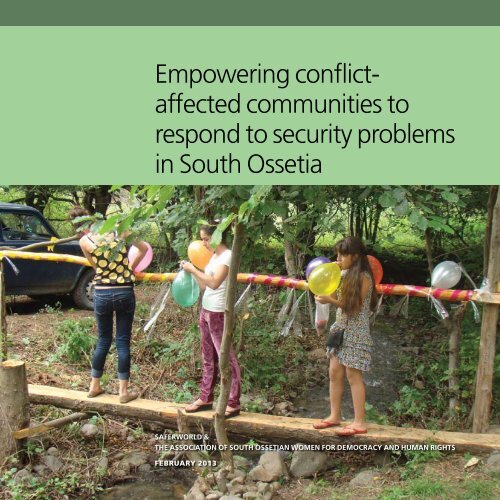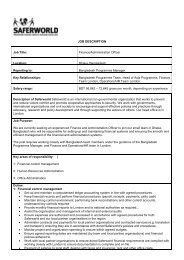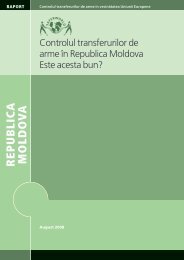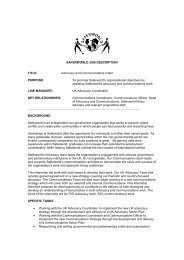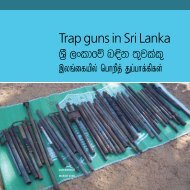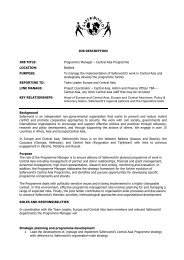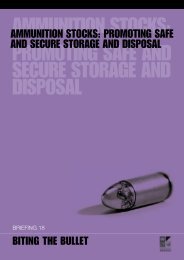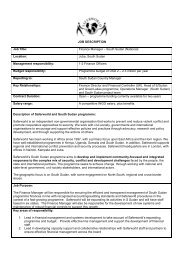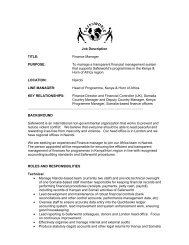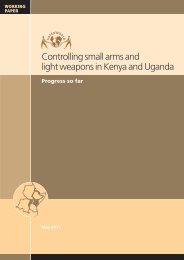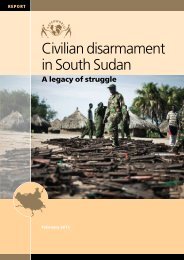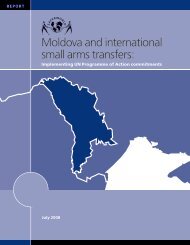Empowering conflict- affected communities to respond ... - Saferworld
Empowering conflict- affected communities to respond ... - Saferworld
Empowering conflict- affected communities to respond ... - Saferworld
- No tags were found...
You also want an ePaper? Increase the reach of your titles
YUMPU automatically turns print PDFs into web optimized ePapers that Google loves.
6 e m p o w e r i n g c o n f l i c t-aff e c t e d c o m m u n i t i e s t o re s p o n d t o s e c u r i t y p ro b l e m s in s o u t h o s s e t i aFigure 2: Five-step process for developing community-led responses5. Implement plansand learn lessons2. Understandpriorities1. Identify<strong>communities</strong> andrepresentatives4. Plan responsesin partnership withsecurity ac<strong>to</strong>rs3. Select issues<strong>to</strong> <strong>respond</strong> <strong>to</strong>The first step in all districts was <strong>to</strong> identify target <strong>communities</strong> in which we would work.Each community is made up of a several villages, grouped <strong>to</strong>gether according <strong>to</strong> (a) sharedneeds, such as economic opportunities, level of physical insecurity, or basic livelihood needs(e.g. access <strong>to</strong> water); and (b) shared views and interests, such as schools, relatives, andfriends. The process of grouping villages in<strong>to</strong> larger <strong>communities</strong> with shared needs andinterests allows people living in those areas <strong>to</strong> work <strong>to</strong>gether and support each other <strong>to</strong><strong>respond</strong> <strong>to</strong> common problems. The next step was <strong>to</strong> select a representative from each community<strong>to</strong> form the volunteer network of community representatives, the CRG, <strong>to</strong> providesupport <strong>to</strong> their <strong>communities</strong> and act as a contact point on community security issues: (a)between the community and the programme partners; (b) between individual communitymembers; and (c) between the community and security providers.The selection of <strong>communities</strong> and CRG representatives was made according <strong>to</strong> recommendationsfrom the heads of rural councils and local residents. By engaging with both authorityrepresentatives and local people from the outset of the project, and explaining our approachand aims, the Association of South Ossetian Women was able <strong>to</strong> build support for the projectand ensure that both parties would be supportive of our work at a later stage. It was alsoessential that the CRG members, who would be responsible for organising activities andleading their <strong>communities</strong> in <strong>respond</strong>ing <strong>to</strong> security problems, were respected both withintheir respective <strong>communities</strong> and by the local authority representatives, with whom theywould cooperate.
CRG meeting <strong>to</strong> developproject methodology,Pyatigorsk, January 2012.© s a f e r w o r l d➜s a f e r w o r l d · t h e a s s o c i a t i o n o f s o u t h o s s e t i a n w o m e n f o r d e m o c r a c y a n d h u m a n r i g h t s 7Once selected, the CRG were invited <strong>to</strong> a meeting with <strong>Saferworld</strong> and the Association ofSouth Ossetian Women in Pyatigorsk in the North Caucasus, Russia <strong>to</strong> develop a joint visionfor understanding and <strong>respond</strong>ing <strong>to</strong> <strong>communities</strong>’ needs in South Ossetia. This initialmeeting was the start of a series of meetings designed <strong>to</strong> develop the capacity of the CRG <strong>to</strong>become a sustainable resource for <strong>respond</strong>ing <strong>to</strong> <strong>communities</strong>’ needs.Understanding problemsIn order <strong>to</strong> understand the safety and security needs in each community, the Association ofSouth Ossetian Women supported each community representative in conducting meetingsin their community, during which they asked local people <strong>to</strong> identify the key issues underminingfeelings of security in their village and the surrounding area. They were also asked <strong>to</strong>identify their security priorities and the amount of assistance that would be needed <strong>to</strong><strong>respond</strong> <strong>to</strong> their priorities. The information from these group discussions was captured in‘community profiles’, which include a brief description of the community; the impact of the<strong>conflict</strong>; local security priorities; how the community already <strong>respond</strong>s <strong>to</strong> these priorities;and how security ac<strong>to</strong>rs <strong>respond</strong> <strong>to</strong> them. These brief profiles are then used <strong>to</strong> clearly explain<strong>communities</strong>’ problems <strong>to</strong> security ac<strong>to</strong>rs with a role in <strong>respond</strong>ing <strong>to</strong> <strong>communities</strong>’ needs.They can also help <strong>communities</strong> <strong>to</strong> categorise their needs and identify priority issues <strong>to</strong>resolve.The findings from these meetings, summarised in figure 3, demonstrate that many problemsfaced by <strong>communities</strong> in South Ossetia are interrelated. People are concerned that poor livingconditions often related <strong>to</strong> the <strong>conflict</strong> situation – for example, through war-time destructionof utilities infrastructure – are driving people <strong>to</strong> leave the area, increasing feelings of isolationand causing uncertainty for the future.
s a f e r w o r l d · t h e a s s o c i a t i o n o f s o u t h o s s e t i a n w o m e n f o r d e m o c r a c y a n d h u m a n r i g h t s 9Selecting prioritiesFollowing the process of understanding <strong>communities</strong>’ needs, the community representativesmet <strong>to</strong> compare the situation in <strong>communities</strong> in different parts of South Ossetia and <strong>to</strong>develop a shortlist of specific <strong>communities</strong> and priority problems <strong>to</strong> which the CRG couldsupport responses. The selection process <strong>to</strong>ok place against the following criteria:n The problem should be resolvable: (a) in a short time, and (b) with limited resources.n The problem should be essential for community security, in that: (a) its existence underminesthe community, and (b) it is linked <strong>to</strong> the <strong>conflict</strong>.n The problem should be general, in that: (a) it is shared by people in the community, and (b)also exists in other <strong>communities</strong> – so that its resolution would provide a positive example.n The problem can be resolved through active participation of <strong>communities</strong>: (a) by themselves,and (b) in partnership with authority representatives.It is very important that the selection of <strong>communities</strong> in which <strong>to</strong> implement initiatives ismade transparently by community representatives on the basis of discussions with localpeople, the rest of the community network, and partners. Accordingly, following the meetingthe shortlist of possible <strong>communities</strong> and issues was discussed with community members <strong>to</strong>update them on progress and get their agreement on the recommended locations and issues.During the first phases of work in Dzhava, Znaur/i and Tskhinval/i districts, the followingpriority problems were identified:n Buzal community, Dzhava district: lack of access <strong>to</strong> drinking and household watern Teregevan community, Znaur/i district: lack of mills in Znaur/i district, leading <strong>to</strong> insecuritymilling grainn Dmenisi community, Tskhinval/i district: lack of a functioning water mill, leading <strong>to</strong> insecuritymilling grainn Rustav community, Tskhinval/i district: destroyed water lines, leading <strong>to</strong> insecurity collectingdrinking waterIn all four cases, the problems were fuelling fears of depopulation of young people.Planning responses in partnership with authoritiesThe next stage was <strong>to</strong> plan responses <strong>to</strong> the selected problems. To ensure a comprehensiveresponse <strong>to</strong> the problems, the CRG members analysed the root causes of individual problemsand identified who or what was responsible for them. They were then supported <strong>to</strong> formulatea description of the problem: who it affects and why it is of importance <strong>to</strong> the <strong>affected</strong>community. This process is essential <strong>to</strong> support <strong>communities</strong> <strong>to</strong> effectively explain both theproblem and the need <strong>to</strong> work on it <strong>to</strong> relevant security ac<strong>to</strong>rs.
10 e m p o w e r i n g c o n f l i c t-aff e c t e d c o m m u n i t i e s t o re s p o n d t o s e c u r i t y p ro b l e m s in s o u t h o s s e t i aOn the basis of these problem statements, the CRG members drafted solution strategies.These included an overall vision of the change the <strong>communities</strong> hoped <strong>to</strong> initiate; a descriptionof the key preconditions for achieving this; and a list of concrete steps and activities that theyintended <strong>to</strong> take <strong>to</strong> achieve their vision of change. The CRG members then met separatelywith (a) people in the selected <strong>communities</strong> and (b) authority representatives, in order <strong>to</strong>consult on the plans and agree their roles in implementation. Before implementing the plans,the CRG members organised a final, joint meeting between <strong>communities</strong> and authorityrepresentatives <strong>to</strong> agree the ultimate plans <strong>to</strong> be implemented. This was essential <strong>to</strong> promoteone of the major goals of the work: changing relationships between <strong>communities</strong> and securityac<strong>to</strong>rs <strong>to</strong> ensure they view each other as willing and able partners in solving security issues.The project partners only provided the <strong>communities</strong> with very small sums of money (300euros per initiative) for the implementation of strategies. This increases the sustainability ofthe approach by compelling <strong>communities</strong> <strong>to</strong> think of creative ways of <strong>respond</strong>ing <strong>to</strong> problemswith limited resources, either by attracting resources from other sources (e.g. security ac<strong>to</strong>rs)or developing innovative, low-cost solutions <strong>to</strong> identified problems.Implementing plans and learning lessonsThe final stage was <strong>to</strong> implement the plans and learn lessons. Throughout 2012, CRGmembers supported local people <strong>to</strong> realise four initiatives in Dzhava, Tskhinval/i andZnaur/i districts, <strong>respond</strong>ing <strong>to</strong> the prioritised problems outlined above. Although the workwas led by community members, they were supported by local authority structures, whichprovided technical equipment <strong>to</strong> assist implementation. Community members in Dzhavaand Znaur/i are currently working on two larger-scale initiatives which will be implementedin the first half of 2013.
Members of Dmenisicommunity renovating thewater mill building,Tskhinval/i district,Oc<strong>to</strong>ber 2012.© t h e a s s o c i a t i o n o fs o u t h o s s e t i a n w o m e n➜s a f e r w o r l d · t h e a s s o c i a t i o n o f s o u t h o s s e t i a n w o m e n f o r d e m o c r a c y a n d h u m a n r i g h t s 11
12 e m p o w e r i n g c o n f l i c t-aff e c t e d c o m m u n i t i e s t o re s p o n d t o s e c u r i t y p ro b l e m s in s o u t h o s s e t i aCase study one: Buzal community, Dzhava districtThe problem: Following damage <strong>to</strong> the water system during the <strong>conflict</strong>, people living in Buzalwere unable <strong>to</strong> access drinking and household water. Although the main water pipe was beingrenovated, there were no plans <strong>to</strong> connect this <strong>to</strong> Buzal, causing the community <strong>to</strong> feel neglectedand raising concerns about the sustainability of the community.Vision of change: Work with the local authorities responsible for renovating the water system <strong>to</strong>ensure that Buzal was also provided access <strong>to</strong> drinking and household water.Steps taken:n The CRG members met several times with representatives and the head of the localadministration <strong>to</strong> present the problem and agree a plan for <strong>respond</strong>ing. A joint meeting wasthen organised between the community and local administration <strong>to</strong> finalise the plan and agreeroles.n Four members of the community used the micro grant <strong>to</strong> buy plastic piping <strong>to</strong> bring water fromthe main pipe <strong>to</strong> Buzal.n The administration provided technical equipment <strong>to</strong> dig a channel from the main pipe <strong>to</strong> thevillage.n The villagers then agreed with the construction workers working on the main pipe <strong>to</strong> connectthe new pipe <strong>to</strong> the main pipe. The villagers themselves laid the pipe in <strong>to</strong> the channel and usingtheir own resources purchased hoses <strong>to</strong> bring water from the central pipe in the village <strong>to</strong> theirhomes.CRG representatives areshown equipment providedby the local administrationduring the implementationof the initiative in Buzalcommunity, April 2012.© t h e a s s o c i a t i o n o fs o u t h o s s e t i a n w o m e nCommunity members layplastic piping <strong>to</strong> bring water<strong>to</strong> Buzal community, Dzhavadistrict, May 2012.© t h e a s s o c i a t i o n o fs o u t h o s s e t i a n w o m e nCommunity members inBuzal turn on the tap aftersuccessfully laying a pipe <strong>to</strong>bring water <strong>to</strong> the village,Dzhava district, May 2012.© t h e a s s o c i a t i o n o fs o u t h o s s e t i a n w o m e n
s a f e r w o r l d · t h e a s s o c i a t i o n o f s o u t h o s s e t i a n w o m e n f o r d e m o c r a c y a n d h u m a n r i g h t s 13t o p l e f t: The mill in Teregevancommunity prior <strong>to</strong> beingrenovated by the community,Znaur/i district, April 2012.t o p r i g h t : The mill inTeregevan community havingbeen successful renovated bythe community, Znaur/idistrict, February 2013.b o t t o m l e f t: A man looks atpho<strong>to</strong>graphs of workimplemented by thecommunity at the opening ofthe mill, Znaur/i district,August 2012.b o t t o m r i g h t : Preparationsfor the opening of the mill,Znaur/i district, August 2012.© t h e a s s o c i a t i o n o fs o u t h o s s e t i a n w o m e n➜Case study two: Teregevan community, Znaur/i districtThe problem: Following damage <strong>to</strong> water mills located in the community during the 2008 war,people have had <strong>to</strong> travel <strong>to</strong> the city <strong>to</strong> grind grain. Poor public transport meant that many had<strong>to</strong> return home late at night, and faced attacks by wild animals from a forest bordering thecommunity.Vision of change: Community members work with representatives of the local administration <strong>to</strong>res<strong>to</strong>re at least one watermill. As a result community members are able <strong>to</strong> mill grain, removing theneed <strong>to</strong> travel <strong>to</strong> the city, which undermines peoples’ feelings of security. Successful res<strong>to</strong>ration ofthe mill can act as a precedent <strong>to</strong> repair other mills in the community.Steps taken:n Community representatives met with local people and the head of the local administration <strong>to</strong>agree a plan for rebuilding one of the water mills in the area. Although the CRG had initiallyplanned <strong>to</strong> renovate an existing mill, the state of the mill meant they had <strong>to</strong> rebuild the mill fromscratch.n The community used the 300 euro micro grant <strong>to</strong> buy an old wooden house, which theydisassembled <strong>to</strong> provide wood <strong>to</strong> rebuild the mill. The local administration provided a vehicle <strong>to</strong>transport the material, as well as concrete piles and an excava<strong>to</strong>r <strong>to</strong> set the foundations.Additional wooden posts were provided by a private company.n The community under<strong>to</strong>ok voluntary work <strong>to</strong> rebuild the mill. During implementation of work,the villagers provided those working with food and refreshments.n Once the mill was functioning, the community organised an opening ceremony and invited alongrepresentatives from local and Tskhinval/i authorities <strong>to</strong> celebrate the success of their joint work.
14 e m p o w e r i n g c o n f l i c t-aff e c t e d c o m m u n i t i e s t o re s p o n d t o s e c u r i t y p ro b l e m s in s o u t h o s s e t i aResults of initiatives“The mill in Teregevancommunity was practically builtfrom scratch. The initiative setsa precedent not just for other<strong>communities</strong> in Znaur/i district,but for all South Ossetia,demonstrating that acommunity can take theinitiative <strong>to</strong> resolve a problem.”CRG memberAll four planned initiatives were successfully implemented, providing <strong>communities</strong> withaccess <strong>to</strong> drinking water (Buzal and Rustav <strong>communities</strong>) and functioning water mills(Dmenisi and Teregevan <strong>communities</strong>). Further <strong>to</strong> these concrete results, the initiatives set aprecedent in the post-war period, since this was the first occasion of people coming <strong>to</strong>gethersince the initial outbreak of violence <strong>to</strong> actively resolve a problem, despite limited resourcesavailable. This has set a positive example for other <strong>communities</strong> and proved a stimulus forfurther independent action by <strong>communities</strong>: for example, following the successful work inRustav community, residents in the village of Khetagurovo, at their own initiative and usingtheir own funds, laid water lines in the streets of the village. The initiatives have fostered awillingness <strong>to</strong> take an active part in society, suggesting movement beyond the ‘victimsyndrome’ and disengagement from civic processes. Furthermore, the initiatives provide aunique example of people cooperating with the administration and vice versa, allowing forthe growth of mutual trust and partnership in <strong>respond</strong>ing <strong>to</strong> problems.
153Achievements and visionfor the futureThis section sets out achievements of the work <strong>to</strong> date, before looking ahead <strong>to</strong> the partners’plans for the future.AchievementsAs noted in section 1, during the initial phases of work the partners hoped <strong>to</strong> demonstratethe potential for facilitating joint responses between <strong>communities</strong> and security providers<strong>to</strong> <strong>communities</strong>’ security needs. Work <strong>to</strong> date has provided a strong foundation for this,demonstrating concrete achievements:Successful responses <strong>to</strong> <strong>communities</strong>’ priorities. The initiatives have been successfullyimplemented, demonstrating that it is possible <strong>to</strong> <strong>respond</strong> <strong>to</strong> <strong>communities</strong>’ priorities withvery limited available funds.Increased access <strong>to</strong> information on <strong>communities</strong>’ needs. The mapping of <strong>communities</strong>’ safetyconcerns was the first survey of needs since the 2008 war. As such, the results have beensought by ac<strong>to</strong>rs within South Ossetia with a role in ensuring <strong>communities</strong>’ safety andwelfare.
16 e m p o w e r i n g c o n f l i c t-aff e c t e d c o m m u n i t i e s t o re s p o n d t o s e c u r i t y p ro b l e m s in s o u t h o s s e t i aWork has also led <strong>to</strong> developments within the three key change areas identified by<strong>communities</strong> at the outset of the project:“After the initiatives, peoplein the community felt moreconfident in themselves andin the future.”CRG member1. Change within <strong>communities</strong>. Following years of social degradation arising from almost twodecades of violent <strong>conflict</strong>, people living in the selected <strong>communities</strong> have demonstratedwillingness and enthusiasm <strong>to</strong> participate in developing and implementing solutions <strong>to</strong>problems. For example, they provided physical labour <strong>to</strong> implement initiatives withoutany financial incentive, and even provided communal food and refreshments during implementation.2. Change in relationships between <strong>communities</strong>. By creating a committed, enthusiasticvolunteer community network, the project has created a potentially sustainable resource forsharing information and providing mutual support between representatives of <strong>communities</strong>from different parts of South Ossetia.3. Change in relationships between <strong>communities</strong> and authority representatives. The implementationof joint initiatives provided an example of constructive cooperation between<strong>communities</strong> and authority representatives. Local authorities have demonstrated a willingness<strong>to</strong> work with <strong>communities</strong> <strong>to</strong> <strong>respond</strong> <strong>to</strong> problems, for example, by providing technicalequipment and materials.To consolidate these achievements and move <strong>to</strong> the next stage in ensuring security for<strong>communities</strong>, the partners have identified two key areas for future activities.Vision for the future1. Strengthening CRG and facilitating greater engagement between <strong>communities</strong>and security ac<strong>to</strong>rsIn the next phase of work, we plan <strong>to</strong> extend our work and identify <strong>communities</strong> andrepresentatives in Akhalgori/Leningor district, <strong>to</strong> allow the project partners <strong>to</strong> support<strong>communities</strong> throughout South Ossetia. We will seek <strong>to</strong> provide additional support <strong>to</strong> thecommunity members, helping them <strong>to</strong> articulate their security needs more clearly <strong>to</strong>security providers; and <strong>to</strong> build their confidence <strong>to</strong> work on other security issues, beyondthose related <strong>to</strong> infrastructure destroyed during the <strong>conflict</strong>.A key objective of a community-based approach is <strong>to</strong> strengthen relations between<strong>communities</strong> and security ac<strong>to</strong>rs, <strong>to</strong> develop mutual trust, and <strong>to</strong> ensure that security ac<strong>to</strong>rsprioritise local needs and use whatever resources are available <strong>to</strong> <strong>respond</strong> <strong>to</strong> them. We thereforehope <strong>to</strong> see closer cooperation between our community network and security ac<strong>to</strong>rsbeyond consultation over specific plans.
s a f e r w o r l d · t h e a s s o c i a t i o n o f s o u t h o s s e t i a n w o m e n f o r d e m o c r a c y a n d h u m a n r i g h t s 172. Increase information available on <strong>communities</strong>’ needsSecurity providers must have access <strong>to</strong> accurate information on local security issues <strong>to</strong> beable <strong>to</strong> ensure an appropriate response. While security ac<strong>to</strong>rs tend <strong>to</strong> have information onthe problems <strong>communities</strong>’ face, it is also important that they understand how this affects<strong>communities</strong>’ perceptions of security, in order <strong>to</strong> <strong>respond</strong> <strong>to</strong> those problems that mostundermine <strong>communities</strong>’ feelings of safety and stability. Accordingly, <strong>Saferworld</strong> and theAssociation of South Ossetian Women intend <strong>to</strong> conduct in-depth research among local<strong>communities</strong> in order <strong>to</strong> measure their perceptions of security. This research will be sharedwith <strong>communities</strong> and security ac<strong>to</strong>rs <strong>to</strong> encourage discussions about how best <strong>to</strong> <strong>respond</strong><strong>to</strong> these problems.
18 e m p o w e r i n g c o n f l i c t-aff e c t e d c o m m u n i t i e s t o re s p o n d t o s e c u r i t y p ro b l e m s in s o u t h o s s e t i aProfiles of implementing partners<strong>Saferworld</strong><strong>Saferworld</strong> works <strong>to</strong> prevent and reduce violent <strong>conflict</strong> and promote cooperative approaches <strong>to</strong>security. We work with governments, international organisations and civil society <strong>to</strong> encourage andsupport effective policies and practices through advocacy, research and policy development andthrough supporting the actions of others.In the present project, <strong>Saferworld</strong> provides the ‘community-based approach <strong>to</strong> security’ and isresponsible for overall project management, including analysis of impact.For more information, visit: www.saferworld.org.ukThe Association of South Ossetian Women for Democracy and Human RightsThe Association of South Ossetian Women for Democracy and Human Rights is an NGO basedin Tskhinval/i. It was founded in 2002 <strong>to</strong> contribute <strong>to</strong> the establishment of a diverse civil society inSouth Ossetia and promote the rule of law and protection of human rights. Its main activities includeconducting trainings, seminars and round tables on human rights, gender issues, <strong>conflict</strong> resolutionand peace building, as well moni<strong>to</strong>ring of human rights in South Ossetia and taking subsequent legalaction.The Association of South Ossetian Women has primary responsibility for implementing the project,including acting as the primary point of contact for the Community Reference Group and liaisingwith security ac<strong>to</strong>rs inside South Ossetia.
ABKHAZIARUSSIAN FEDERATIONBLACKSEASOUTHOSSETIATskhinval/iGEORGIACASPISEATURKEYARMENIAAZERBAIJANYerevanNAGORNYKARABAKHStepanakertNAKHCHEVANAZERBAIJANTERRITORYUNDERARMENIANCONTROLIRANThis map is intended for illustrative purposes only. <strong>Saferworld</strong> takes no position on whether this representation is legally or politically valid.
The 2008 war over South Ossetia was the dramatic culmination of yearsof <strong>conflict</strong>. Although the situation has stabilised since the 2008 ceasefire,on-going violence during the previous nineteen years has left lastinginfrastructural, economic, and psychological damage. Today local residentsface a range of daily challenges, from reduced opportunities <strong>to</strong> earn aliving <strong>to</strong> concerns around unexploded ordnance, which undermine bothperceptions of security and peaceful development of <strong>communities</strong>.In response, <strong>Saferworld</strong> and the Association of South Ossetian Women forDemocracy and Human Rights have been working with <strong>conflict</strong>-<strong>affected</strong><strong>communities</strong> in Dzhava and Znaur/i districts since November 2011 and inTskhinval/i district since April 2012, supporting <strong>communities</strong> <strong>to</strong> work withlocal security ac<strong>to</strong>rs <strong>to</strong> improve security at the local level. This publicationoutlines the partners’ approach during this initial phase of work.Cover pho<strong>to</strong>: Girls preparing for the opening ceremony of a mill renovated by thecommunity, Znaur/i district, August 2012. © t h e a s s o c i a t i o n o f south ossetian w o m e nThe project, including this publication, was funded by the UK Conflict Pool. The contentsof the publication are the sole responsibility of the authors and do not necessarily reflectthe views of the UK government.<strong>Saferworld</strong>The Grays<strong>to</strong>n Centre28 Charles SquareLondon N1 6HTUKPhone: +44 (0)20 7324 4646Fax: +44 (0)20 7324 4647Email: general@saferworld.org.ukWeb: www.saferworld.org.ukISBN: 978–1–904833-99-4The Association of South Ossetian Womenfor Democracy and Human Rights37 Ulitsa GagloevaTskhinval/iPhone: +7 928 688 6265


